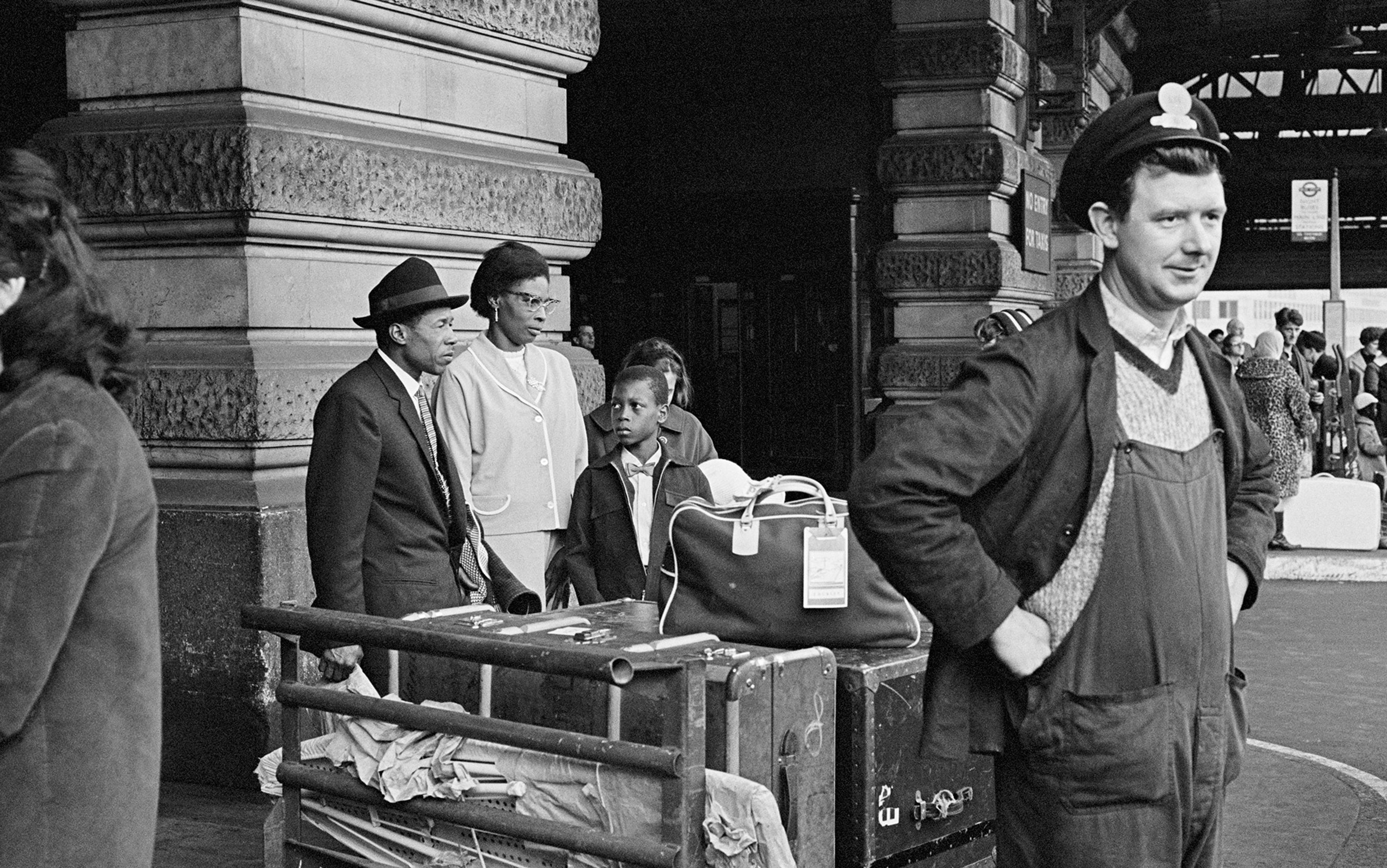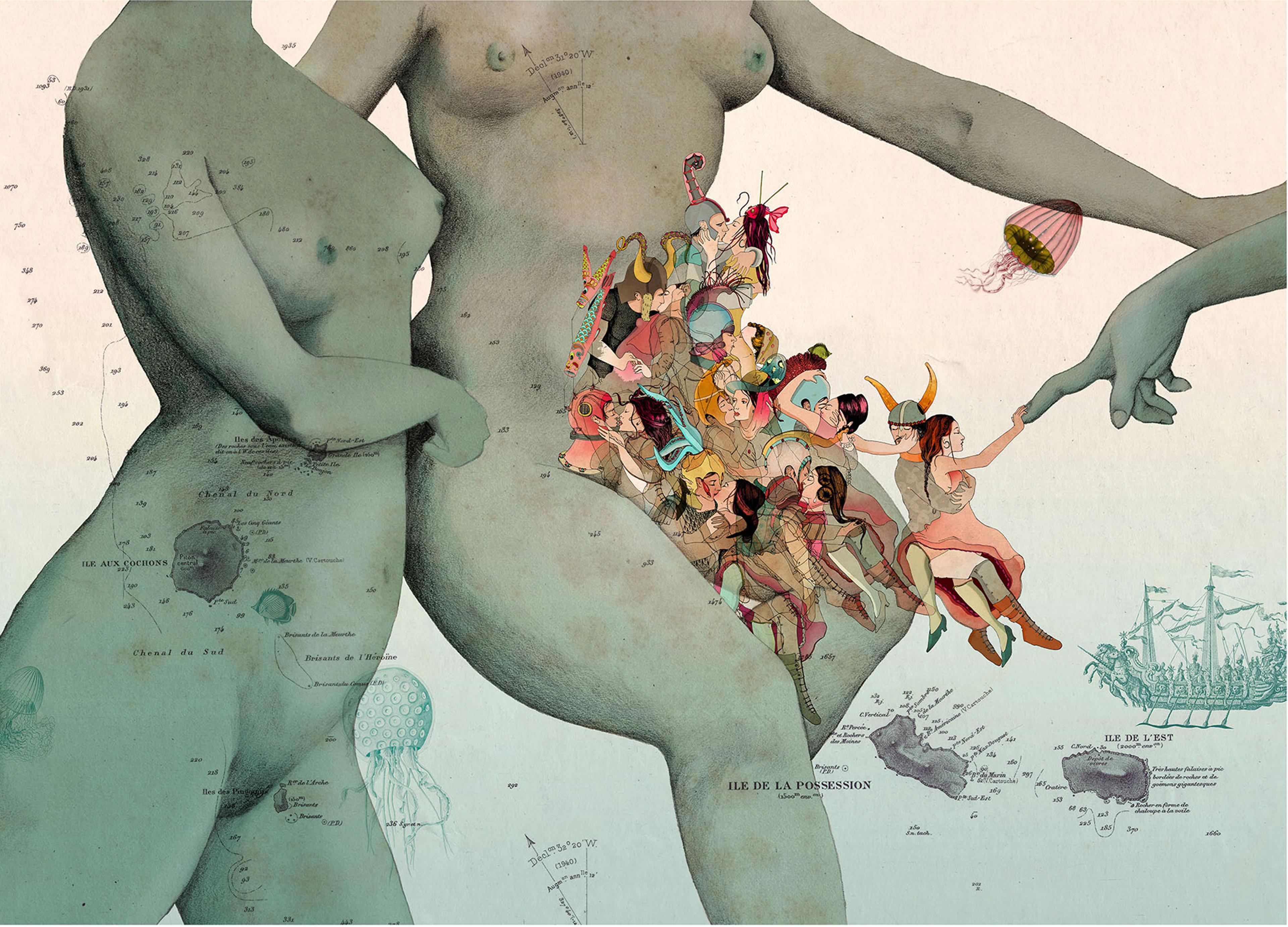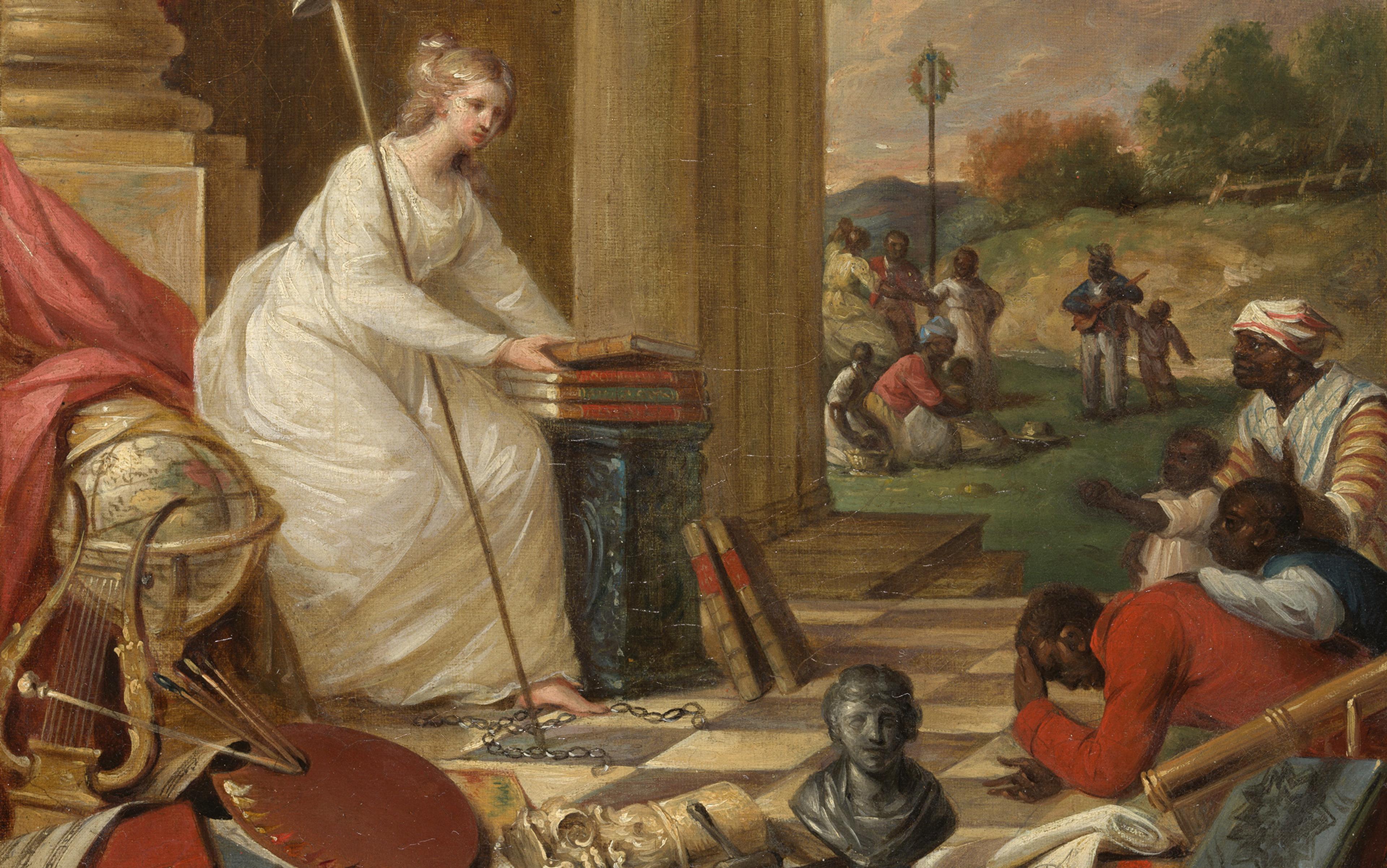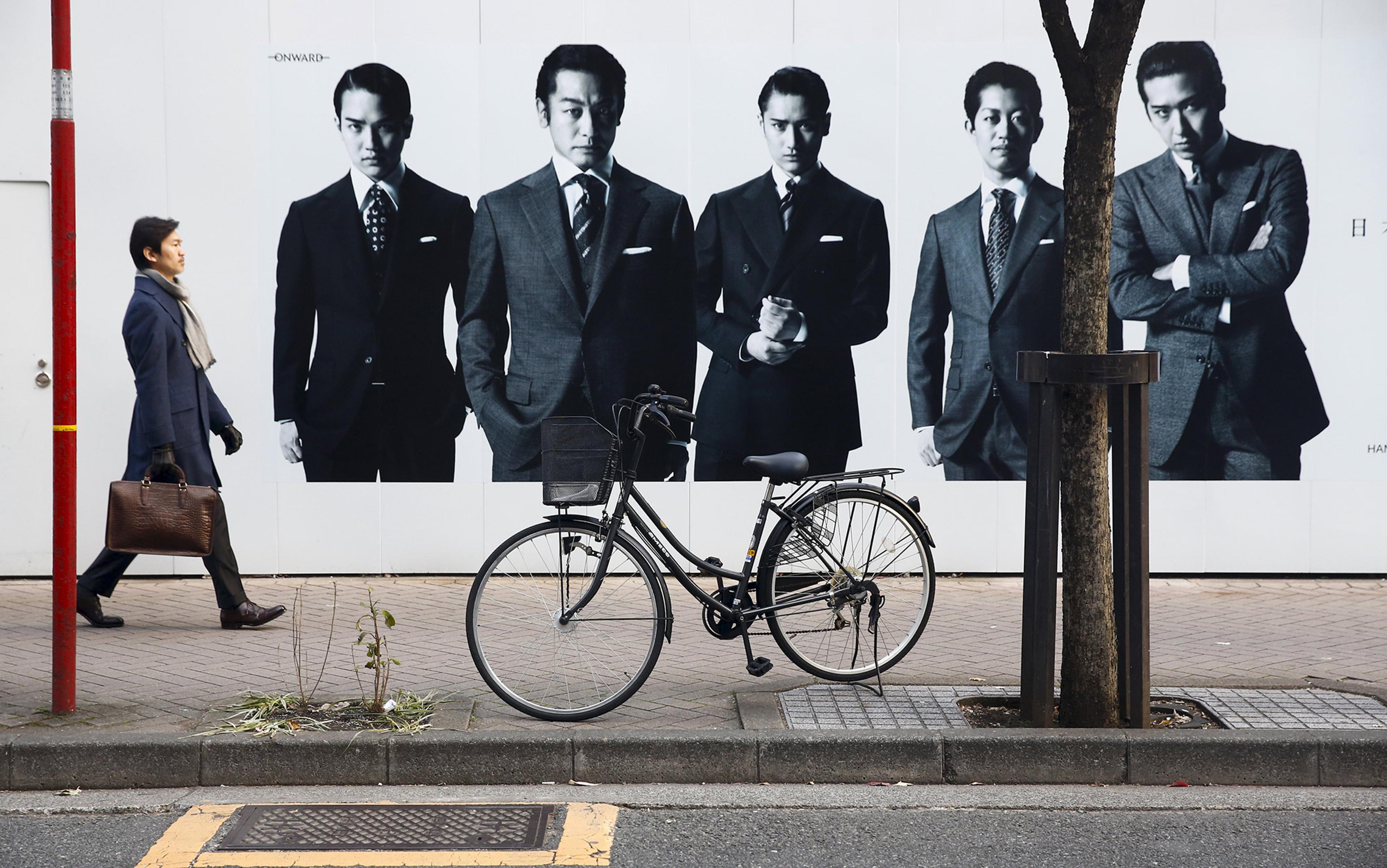Boarding a train in France a few years after the Second World War, a medical student specialising in psychiatry at a prestigious university, a man who had previously volunteered and fought for the Free French forces against the Nazis, found himself being pointed out by a small child: ‘Look, a Negro! Maman, a Negro!’
For the student, those words triggered a psychic storm of associations and identification that crystallised the racism of his society into one intense episode of distress.
‘I cast an objective gaze over myself,’ he later wrote of the incident, and was ‘deafened by cannibalism, backwardness, fetishism, racial stigmas, slave traders’ and, above all, the pidgin refrain of the grinning cartoon character in adverts for a banana-flavoured breakfast cereal.
These associations that made up the stereotype of un nègre carried with them an incoherent mix of condescension, pity, fear and disgust. The child was amused, then scared. The student’s distress was in seeing himself through this cluster of negative associations and feelings.
That student was Frantz Fanon, and his description of this incident is central to his analysis of the psychic distress caused by racism. He initially wrote this as the dissertation for his medical degree, but his supervisor thought such an unusual work was unlikely to pass. Fanon submitted a dissertation on spinal degeneration instead, and his theory of the psychological structures and effects of racism became his first book, Black Skin, White Masks (1952).
Fanon’s theory rests on the idea that we unwittingly inherit aspects of our worldview from our society. In this way, it bears important parallels with Simone de Beauvoir’s theory of gender in The Second Sex, published only three years earlier.
Both these philosophers argue that ideas and values instilled in us through childhood shape our adult lives, often in ways that we are unaware of. They agree that these aspects of our outlook can remain quietly influential on our thought and behaviour, even after we have rejected them. Both consider the tension between our own ideas and values and those inherited from our society to be a source of difficulty and distress.
De Beauvoir identifies this social conditioning as the origin of gender. Society enforces different expectations of boys and girls, presented as reflecting natural differences between them. Boys are encouraged to explore and dominate their environments. Girls are required to be helpful and pleasing. Different values are thereby instilled in boys and girls, along with a shared belief in the supposedly natural differences between the sexes. Even a woman who has rejected these ideas in adult life cannot easily escape their influence on her thought and behaviour.
Fanon’s analysis of racial categorisation is similar. Black and white children in French culture at the time were all raised on the same stories and films, which presented Europeans as superior to Africans. All children were taught to consider themselves European, which helped to instil in black children the same image of African inferiority that was instilled in white children. Adults who reject this stereotype, argues Fanon, cannot easily overcome its influence on their thought and behaviour.
Current research in social psychology confirms that our outlooks incorporate ideas and values that we do not endorse but have absorbed from our societies. But this research into what has become known as ‘implicit bias’ focuses on its effects on our behaviour towards other people. De Beauvoir and Fanon, by contrast, focus on its effects on the opportunities that seem open to us and on how we think about ourselves. Their analyses from this different perspective could open up fruitful new avenues for research into the nature and effects of implicit bias.
One kind of implicit-bias research has focused on the associations that make up stereotypes. Experiments show these associations influencing people’s behaviour, even when they explicitly deny that the association is true. When asked to identify objects very quickly, for example, people’s responses can indicate an association between black men and handguns, even when they deny that there is any such association.
In one experiment from 2006, pictures of handguns and power tools appear in quick succession, and people have to identify each object. Before each picture appears, there is a brief image of a face. When this is the face of a black man, people correctly identify handguns more quickly and misidentify power tools as handguns more often than they do when it is the face of a white man. This happens only at high speed. Given just a little thinking time, people easily distinguish handguns from power tools, regardless of the face they have just seen.
In another experiment from 2002, participants play a video game where images of people appear on the screen, some of them carrying handguns. The player must press one button to shoot an armed character or another button to register that the character is unarmed. The scoring system requires players to make this decision quickly. When the decision time is very quick, players shoot unarmed black characters more often than they shoot unarmed white characters, and they fail to shoot armed white characters more often than they fail to shoot armed black characters.
When this experiment is slowed down so that players have a little more time to make their decision, they are much more accurate in shooting all the armed characters and not shooting any unarmed ones. But even in this version, players make the decision to shoot more quickly when an armed character is black than when he is white. And they make the decision not to shoot more quickly when an unarmed character is white than when he is black.
Why does this happen? It looks like a combination of two things. People’s minds include an association between black men and handguns. And those people reject the idea that there is such an association in the real world. When they have time to prevent this association from influencing their action, they can do so. But when they have to make their decision very quickly, the association influences the action.
The same association might involve negative feelings in a police officer but positive feelings in a gangsta-rap fan
So far, this fits very well with Fanon’s description of his experience. Although he is describing a traumatic experience rather than a split-second decision, the underlying point remains the same: the influence of a cognitive association deep in the mind of someone who does not agree with it.
Two details of these experiments confirm this alignment with Fanon’s theory. The bias does not correlate with the ethnicity of the person whose behaviour is being monitored. In the video-game experiment, black players and white players show the same bias. But the bias does correlate with knowledge of the relevant stereotype. Before playing the video game, players were asked to estimate how aggressive, dangerous and violent most white Americans consider African Americans to be. Each player’s bias in the game correlated with their responses to these measures.
These details support Fanon’s contention that we have all ‘breathed in and ingested the myths and prejudices’ embodied in our media, and that these can influence our thought and behaviour even though we reject them. But these experiments offer Fanon only limited support. His theory is about a network of associations triggered simultaneously. Social psychology tends to measure associations individually without testing for the relations between them.
Perhaps more importantly, Fanon’s theory is that these associations carry negative feelings with them. This is why Fanon labels the stereotype of black men ‘negrophobia’. It is easy to assume that an association with handguns would bring a negative feeling with it. But much of the media associating black men with handguns glamorises both. The same association might involve negative feelings in a police officer but positive feelings in a gangsta-rap fan.
Implicit-bias researchers do investigate positive and negative feelings. One experiment from 1998 asks white people to classify names (such as Ebony, Jed, Katie, Lamar) as typically names of white people or of black people, at the same time as classifying other words (crash, happy, peace, rotten) as describing pleasant or unpleasant things.
The experiment shows subjects classifying the names more quickly when one button is used for white names and pleasant things, and another button for black names and unpleasant things. They respond more slowly when the button for white names is also for unpleasant things, while the other button is for black names and pleasant things. People who show this bias deny preferring white people to black people, and there seems no reason to suspect that their denial is not sincere.
Social psychologists call this kind of bias a prejudice. They call the other kind, such as the association of black men with handguns, a stereotype. Investigations of prejudices tend to be separate from experiments into stereotypes. This separation limits social psychology’s investigation of the kind of holistic racial categorisation that Fanon articulates, which clusters a whole host of associations and feelings so tightly that they can be triggered together in a single overwhelming experience.
A further important difference concerns the effects of these internalised ideas. Social psychology tends to investigate the influence of implicit bias on our behaviour towards other people. Classic experiments measure how likely you are to misperceive an object in someone’s hand as a gun, how highly you rate someone’s career experience as set out in a job application, how far you choose to sit from someone in an otherwise empty waiting room, how much eye contact you make with someone, how long your conversation with someone lasts, and so on.
None of these aspects of behaviour result from conscious decisions. How you perceive the world, how impressed you are by someone’s job application, exactly how far you stand or sit from someone, how much eye contact you make, and how long you chat are not usually things that you explicitly think about. You just do or feel them. They result from automatic cognitive processes.
In this regard, they are like the intense feelings of distress that Fanon describes. But unlike those feelings, these are all aspects of how you behave towards other people. Fanon’s theory is concerned with this too. The child who points him out on the train is expressing an internalised image of a black man in his exclamation, amusement and fear. Fanon goes on to describe the child’s mother’s apologies – ‘he doesn’t realise you are just as civilised as we are’ – which are well-meant but betray the same internalised racial schema.
However, Fanon’s primary focus in Black Skin, White Masks is not on behaviour towards other people. His central concern is with the problems this racial schema of the black man causes to black men who have internalised it. He is not focused on the moral question of how we treat one another, but on the existential question of how we have become the people we are. This existential context shapes his approach to the psychiatric and therapeutic questions of how distress comes about, and how it can be alleviated.
Internalised stereotypes shape the goals we pursue in childhood, adolescence and adult life
A different area of social psychology – one related to but distinct from implicit-bias research – might seem closer to this existential concern. Research into what has become known as ‘stereotype threat’ is concerned with the effect of internalised stereotypes on the behaviour of the people they stereotype. Experiments have concluded that, for example, the stereotype of women as less good than men at mathematics can influence women’s mathematical performance. In one experiment from 1999, two groups of women took the same test, with only one group being told that the test is likely to show a gender difference. That group performed less well than the women who had not been told this.
Three separate analyses of stereotype-threat research, however, have concluded that this effect is at best very weak and perhaps entirely nonexistent. Overall, the evidence simply does not support the idea that stereotypes exert a significant influence on the behaviour of the stereotyped in this way.
Where does this leave de Beauvoir’s version of the existentialist idea that internalised gender stereotypes shape the person you become? Her theory does seem to predict that the association between mathematics and maleness should influence the mathematical achievements of women overall. But it does not predict that the stereotype has the kind of influence that the stereotype-threat experiments look for.
De Beauvoir’s theory is not that being reminded of the stereotype will temporarily lower a woman’s mathematical abilities. Rather, it is that internalised stereotypes shape the goals we pursue in childhood, adolescence and adult life. De Beauvoir argues that, because we all internalise the stereotypes of gender from a young age, and because we develop interests and experience according to our expectations of ourselves and of one another, those stereotypes shape whom we become.
The analyses that show stereotype threat to have little or no influence on behaviour are consistent with de Beauvoir’s theory of how stereotypes shape our lives. These analyses have indeed found a gender disparity at the highest levels of performance on mathematics tests. It is not at all clear why there is such a disparity. Could it be the effect of gender stereotypes shaping the abilities that people develop, as de Beauvoir suggests?
Evidence that stereotypes do shape relevant abilities and experiences is provided by a recent study of 1,400 teachers in Italy and their students. This study measured the teachers’ gender stereotypes using a standard psychological experiment. The teachers were asked to respond to names and academic subjects as these appeared on a screen. They were to press one button for male names and another for female names. Those two buttons were also used to sort the academic subjects between sciences and humanities. Each teacher took two versions of the experiment, with the order of these determined randomly.
In one version, one button was used for male names and sciences, and the other button for female names and humanities. In the other version, one button was used for male names and humanities, the other for female names and sciences. The experimenters measured the difference in response speed in the two versions. If your responses are significantly faster when using the same button for male names and sciences than when using the same button for female names and sciences, this indicates the influence of gender stereotypes on your perception of academic disciplines.
This influence might not be something you agree with. If asked about gender and academic disciplines, you might reply that there are no academic differences between male and female students. But this would be consistent with the stereotype being deeply embedded in your mind and influencing your thought and behaviour in subtle ways that you do not notice.
The experimenters analysed the performance of these teachers’ students on standardised mathematics tests. They found that the gender gap in a class of students correlated with the strength of their teacher’s gender stereotyping of academic disciplines. They also found that female students’ confidence in their own mathematical abilities was lower if their teachers showed a strong gender stereotype when sorting academic disciplines. And they found no significant differences across these groups of students in terms of social background or performance in earlier mathematics tests.
Therefore, gender disparity in mathematical performance at school seems to be significantly influenced by teachers’ stereotyped expectations of student abilities. Together with the influence on student confidence, this suggests that gendered teacher expectations influence students’ choices of academic disciplines, and partly explain the gender disparity in mathematical and scientific careers.
Even women who have repudiated the stereotypes of their upbringing find them influencing their thought
De Beauvoir’s analysis of gender in The Second Sex describes precisely this kind of process. ‘One is not born, but rather becomes, woman.’ So begins de Beauvoir’s analysis of childhood and adolescence, the formative years when parents, teachers, the media and the wider community all influence the goals we pursue, and so shape the abilities we develop.
But there is an aspect to de Beauvoir’s slogan that this experiment does not investigate. Her theory, like Fanon’s theory, focuses on the internalisation of stereotypes deep in the minds of the stereotyped. Gender is not only produced by the thinking and behaviour of the people around you. It is also, de Beauvoir argues, the result of gender stereotypes being deeply embedded in your own mind, shaping your outlook. ‘It is clear that woman’s whole “character” – her convictions, values, wisdom, morality, tastes, and behaviour,’ de Beauvoir concludes, ‘is explained by her situation.’
De Beauvoir mentions that this can be a source of frustration and distress. Even women who have repudiated the stereotypes of their upbringing, she argues, still find these influencing their thought and behaviour in unwanted ways. She does not dwell on this point in The Second Sex. De Beauvoir is a philosopher by training, not a psychiatrist or therapist. But this is the point that brings her theory of gender closest to Fanon’s theory of racialisation. Fanon was a psychiatrist, and this kind of distress was his central concern in Black Skin, White Masks.
The similarities between the theories elaborated in these two books are remarkable, especially as Fanon’s book never refers to de Beauvoir’s. This common idea that they both elaborate in different contexts and with different purposes fits very well with today’s experimental social psychology of implicit bias.
But it also offers some important avenues for further research. How do your own implicit biases shape the abilities you develop and the opportunities you pursue? What effects do they have on your own mental health? How can we be liberated from the constraints they quietly impose on us and from the distress they can cause us?
The existentialism of de Beauvoir and Fanon suggests that we cannot answer these questions if we continue to investigate individual associations or individual prejudices. We need a model of how the tight knot of associations and feelings that constitute an overall stereotype is held together. We need to understand what makes possible the distressing cascade of ideas and feelings that Fanon described so eloquently. And for that, we need to shift from the piecemeal perspective of the experimenter to the holistic perspective of the philosopher. Perhaps the existentialist theories of de Beauvoir and Fanon would be a good place to start in building that model.
Rethinking Existentialism by Jonathan Webber is published via Oxford University Press.






